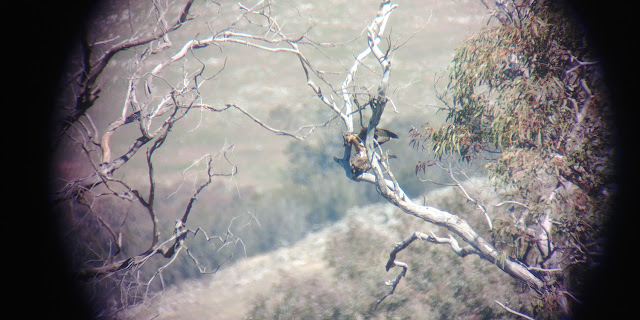This annotated map shows the route of this bird's return migration to Cape York in northern Australia. The large dots are locations where she spent an overnight stop. She left Canberra on 14 March 2020 and arrived at her over-wintering area on 24 March, a journey of ten days. She spent four and a half months in a well-defined area of tropical savannah. Then she set off on her return flight on 17 August, reaching Canberra on the 31st, after a slightly longer journey of 14 days. She is now back in the same territory she occupied in 2019.
Sunday, September 20, 2020
Saturday, August 29, 2020
Distant views
Real life eagle-watching is not like that portrayed on television. The birds are seldom seen in frame-filling format, rather they are specks in the sky or faintly discernable shapes sitting in trees. These views of Little Eagles in a tree next to their nest tree, give a true impression of the view of eagles through a telescope. Click on the images to see more detail.
This female was quite difficult to spot when she was sitting upright. It was only when she moved, and leaned forward that she became just a little more obvious.
Movement is often the main betrayal of any bird's position and when her partner flew onto the branch, the two of them called bringing more attention to their presence.
The Little Eagles in the ACT area are now settling to breed and mating is frequently seen. This pair's nest has been built up with fresh branches and leafy twigs, ready for eggs. And another pair already have an egg, laid on the 19th of August.
Friday, July 31, 2020
Saturday, July 4, 2020
Friday, July 3, 2020
Thursday, July 2, 2020
https://www.publish.csiro.au/ZO/ZO18060
Abstract. The post-breeding migration of an adult male little eagle (Hieraaetus morphnoides) was followed from south-eastern Australia to the Northern Territory using a GPS satellite transmitter. The bird bred in open woodland habitat on the edge of the city of Canberra, Australian Capital Territory (ACT), before it flew more than 3300 km in 18 days, to winter in an area of eucalypt savannah in the Northern Territory. It remained there for 59 days, within a range of ~30 km2 , after which the last signal was transmitted. The bird was subsequently resighted back in its ACT territory at the end of winter, thus completing a return migration. This is the first confirmation of post-breeding migration for the species.





















